30 Top Black Birds with White Stripe on Wing
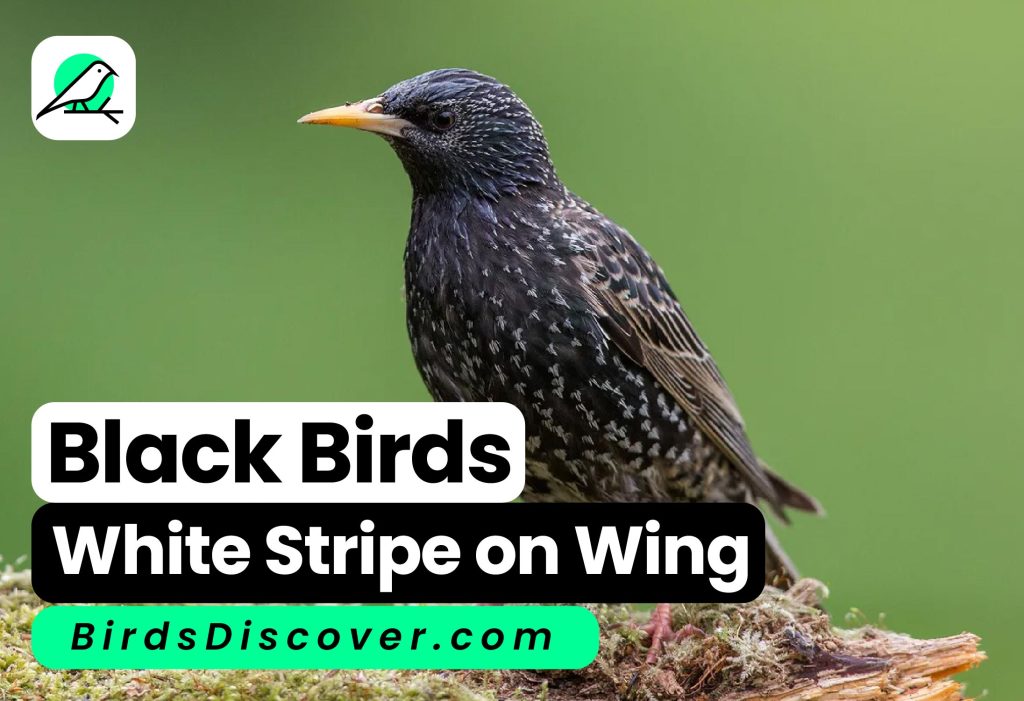
Top Black Birds
Black birds are fascinating creatures that capture the attention of birdwatchers and nature enthusiasts alike. With their sleek, dark plumage and varied behaviors, black birds offer a wealth of information and beauty. The term “black birds” typically refers to several species within the family Icteridae, including the common blackbird, the red-winged blackbird, and the grackle. In this article, we’ll delve into the lives and characteristics of these black birds, exploring their habitats, behaviors, and unique features.
First and foremost, black birds are known for their striking appearance. Their glossy, black feathers often shimmer in the sunlight, creating an almost iridescent effect. This glossy sheen is one of the distinguishing features of black birds. Among these, the common blackbird is particularly notable for its all-black plumage, which is contrasted by a bright yellow beak in males. The red-winged blackbird, another member of the black birds’ family, is easily identifiable by its vivid red and yellow shoulder patches.
Black birds inhabit a variety of environments, ranging from open fields to dense wetlands. The adaptability of black birds to different habitats is one of their strengths. For instance, the red-winged blackbird thrives in marshes and wet meadows, where it builds its nests among the reeds. On the other hand, the grackle prefers urban areas and open woodlands, often seen foraging in parks or along roadways. This versatility in habitat preference allows black birds to maintain stable populations across diverse regions.
Behaviorally, black birds exhibit a range of intriguing traits. Many species of black birds are highly social and are often seen in large flocks, especially during migration or in winter. These flocks can be a spectacular sight, with thousands of black birds moving in unison across the sky. The social nature of black birds is not just for show; it also serves practical purposes, such as finding food and evading predators.
Communication is another interesting aspect of black birds’ behavior. They are known for their varied calls and songs, which serve different functions. For example, the red-winged blackbird has a distinctive “conk-la-ree!” call that is used during breeding season to establish territory and attract mates. Black birds are also known to engage in complex mating rituals. During courtship, males of many black bird species will display their vibrant plumage or perform intricate songs to attract females.
Black birds play significant roles in their ecosystems. They are important seed dispersers, as they feed on a variety of fruits and seeds. By consuming and later excreting seeds, black birds contribute to plant diversity and forest regeneration. Additionally, black birds help control insect populations, as many species feed on insects and other small invertebrates.
Despite their benefits, black birds are sometimes seen as pests, particularly in agricultural areas. Their large flocks can cause significant damage to crops, leading to conflicts with farmers. In such cases, management strategies are employed to mitigate the impact of black birds on agriculture while balancing their ecological importance.
In summary, black birds are remarkable for their distinctive appearance, adaptable nature, and varied behaviors. From their shimmering feathers to their social flocks and diverse calls, black birds offer a wealth of fascinating insights into avian life. Whether observed in urban parks or rural wetlands, black birds continue to captivate and intrigue those who take the time to learn about them. Their role in ecosystems, coupled with their striking presence, ensures that black birds remain an important and cherished part of the natural world.
Characteristics
- Appearance: As their name suggests, black birds are primarily black in color, though some species may have subtle variations, including iridescence or white markings. Their glossy black feathers can have different sheens or tints depending on the species and lighting.
- Size and Shape: Black birds vary greatly in size and shape, from small songbirds to larger, more robust species. They can have different body shapes, wing sizes, and beak forms suited to their feeding and environmental needs.
Habitat
- Diverse Environments: Black birds are adaptable and can be found in a range of environments including forests, grasslands, wetlands, and urban areas. They are often seen in both tropical and temperate regions.
- Migratory Patterns: Some black bird species are migratory, traveling between breeding and wintering grounds, while others may be sedentary and stay within a specific region year-round.
Behavior
- Social Structures: Many black birds are highly social and can be seen in large flocks, especially during migration or in foraging areas. Some species, like crows and ravens, are known for their complex social structures and problem-solving abilities.
- Vocalizations: Black birds are known for their varied and often loud vocalizations. These can range from melodious songs to harsh calls, used for communication, territory defense, and attracting mates.
- Feeding Habits: Their diet is varied and can include insects, fruits, seeds, and small animals. Foraging behavior is adapted to their environment, with some species being ground feeders and others foraging in trees or flying insects.
Notable Species
- American Crow (Corvus brachyrhynchos):
- Appearance: Large, all-black bird with a robust build. Known for its distinctive cawing call.
- Habitat: Found across North America in forests, open fields, and urban areas.
- Behavior: Highly intelligent with complex social behaviors. Known for problem-solving and tool use.
- Common Raven (Corvus corax):
- Appearance: Larger than crows, with a wedge-shaped tail and shaggy throat feathers. Iridescent black plumage.
- Habitat: Prefers wilderness areas, including forests, mountains, and deserts.
- Behavior: Highly adaptable and intelligent. Engages in complex play and has a varied diet.
- Black-capped Chickadee (Poecile atricapillus):
- Appearance: Small songbird with a distinctive black cap and bib, white cheeks, and a buffy underbelly.
- Habitat: Found in forests and woodlands in North America.
- Behavior: Known for its distinctive “chick-a-dee” call and for caching food to survive winter.
- European Starling (Sturnus vulgaris):
- Appearance: Medium-sized bird with iridescent black feathers and speckled plumage. Yellow beak.
- Habitat: Originally from Europe but now widespread in North America.
- Behavior: Highly adaptable and social, often seen in large flocks. Omnivorous diet.
- Red-winged Blackbird (Agelaius phoeniceus):
- Appearance: Males are black with striking red and yellow shoulder patches; females are streaked brown and black.
- Habitat: Common in wetlands, marshes, and grasslands across North America.
- Behavior: Males are known for their territorial displays and distinctive songs.
Conservation
- Threats: Some black bird species face threats from habitat loss, pollution, and climate change. However, many species are adaptable and thrive in various environments, including urban areas.
- Conservation Efforts: Efforts to protect black birds often involve habitat preservation, monitoring populations, and addressing environmental issues that impact their survival.
1. Lark Bunting
The Lark Bunting (Calamospiza melanocorys) is a distinctive bird that inhabits the grasslands and prairies of central North America. A member of the Cardinalidae family, this species is especially renowned for its dramatic seasonal plumage changes. During the breeding season, males display a striking black body with a prominent white wing patch, while females remain brown and streaked for effective camouflage. The Lark Bunting is celebrated for its complex, melodic song and the males’ elaborate flight displays, which are used to attract mates and establish territories. These birds primarily consume seeds and insects and nest on the ground, often concealed by vegetation. They migrate to the southern United States and Mexico for the winter. Despite facing habitat challenges, the Lark Bunting is currently classified as Least Concern by the IUCN, indicating a stable population.

| Attribute | Description |
|---|---|
| Scientific Name | Calamospiza melanocorys |
| Common Name | Lark Bunting |
| Family | Cardinalidae |
| Habitat | Grasslands and prairies of central North America |
| Diet | Seeds, insects |
| Breeding Season | Late spring to summer |
| Nest Location | On the ground, often concealed by vegetation |
| Male Breeding Plumage | Black with a large white wing patch |
| Female Plumage | Brown and streaked, providing camouflage |
| Migration | Migrates to southern United States and Mexico for winter |
| Conservation Status | Least Concern (IUCN) |
| Notable Behavior | Males perform elaborate flight displays during breeding season |
| Song | Complex, melodic song used to attract mates and defend territory |
2. White-Winged Chough
The White-Winged Chough (Corcorax melanorhamphos) is a fascinating bird native to the woodlands, forests, and open country of eastern and southeastern Australia. As a member of the Corcoracidae family, this species is easily identified by its black plumage adorned with distinctive white patches on the wings, visible during flight. Known for their highly social nature, White-Winged Choughs live in cooperative family groups and exhibit strong family bonds, engaging in cooperative breeding. Their diet consists of insects, seeds, small animals, and occasionally carrion. They construct mud nests in trees during their breeding season, which spans from spring to early summer. Despite their complex social structure and unique behaviors, the White-Winged Chough is currently listed as Least Concern by the IUCN, indicating a stable population. Their loud and varied calls play a crucial role in communication within their groups, further emphasizing their social nature.
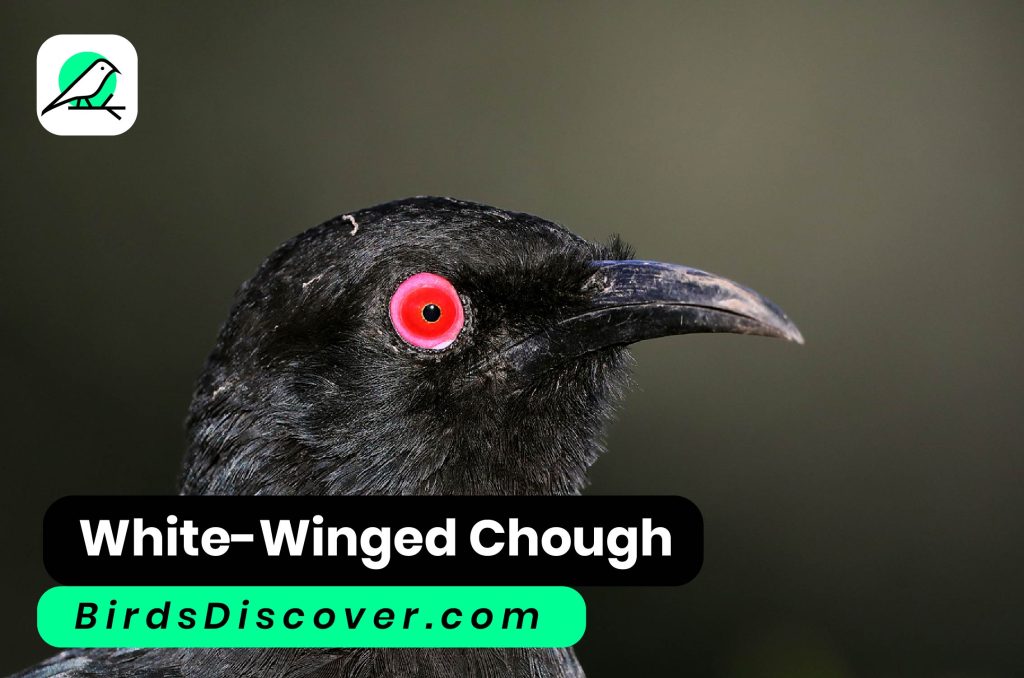
| Attribute | Description |
|---|---|
| Scientific Name | Corcorax melanorhamphos |
| Common Name | White-Winged Chough |
| Family | Corcoracidae |
| Habitat | Woodlands, forests, and open country of eastern and southeastern Australia |
| Diet | Insects, seeds, small animals, and occasionally carrion |
| Breeding Season | Spring to early summer |
| Nest Location | Mud nests built in trees |
| Adult Plumage | Black with white patches on wings, visible in flight |
| Juvenile Plumage | Similar to adults but with brownish eyes |
| Social Structure | Highly social, living in cooperative family groups |
| Conservation Status | Least Concern (IUCN) |
| Notable Behavior | Cooperative breeding and strong family bonds |
| Call | Loud, varied calls often used for communication within groups |
3. Eurasian Magpie
The Eurasian Magpie (Pica pica) is a remarkable bird found across Europe, Asia, and North Africa, inhabiting woodlands, farmlands, grasslands, and urban areas. As a member of the Corvidae family, this species is easily recognizable by its striking black and white plumage, complemented by iridescent blue-green wings and tail. Known for their intelligence and problem-solving abilities, Eurasian Magpies are highly social birds often seen in pairs or small groups. They have an omnivorous diet, consuming insects, small animals, fruits, seeds, and carrion. During the breeding season, which spans from March to July, they build large, domed nests high in trees using twigs and mud. Despite their attraction to shiny objects and their harsh, chattering calls used for communication and alarm, Eurasian Magpies are currently listed as Least Concern by the IUCN, indicating a stable population. Their fascinating behavior and adaptability make them a notable species within their widespread range.
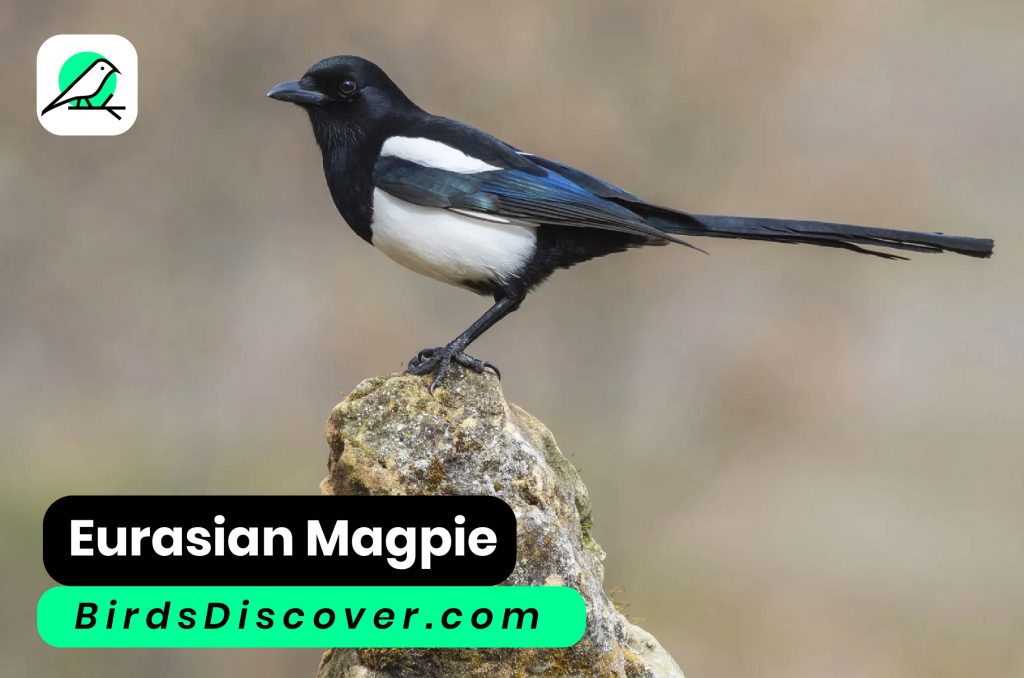
| Attribute | Description |
|---|---|
| Scientific Name | Pica pica |
| Common Name | Eurasian Magpie |
| Family | Corvidae |
| Habitat | Woodlands, farmlands, grasslands, and urban areas across Europe, Asia, and North Africa |
| Diet | Omnivorous: insects, small animals, fruits, seeds, and carrion |
| Breeding Season | March to July |
| Nest Location | High in trees, using twigs and mud to build large, domed nests |
| Adult Plumage | Black and white with iridescent blue-green wings and tail |
| Juvenile Plumage | Similar to adults but with duller colors |
| Social Structure | Often seen in pairs or small groups, highly social and intelligent |
| Conservation Status | Least Concern (IUCN) |
| Notable Behavior | Known for their intelligence, problem-solving abilities, and attraction to shiny objects |
| Call | Harsh, chattering calls used for communication and alarm |
4 Oriental Magpie-robin
The Oriental Magpie-Robin (Copsychus saularis) is an elegant bird native to South and Southeast Asia, thriving in a variety of habitats including forests, gardens, and urban areas. A member of the Muscicapidae family, this species is renowned for its striking appearance and melodious song. Males are adorned with distinctive black and white plumage, while females exhibit a more subdued grayish-black and white coloration. Known for their lively and varied calls, Oriental Magpie-Robins are skilled vocalists and mimics, using their songs to defend their territory and attract mates. They primarily feed on insects, earthworms, small reptiles, and fruits, showcasing their adaptability in diverse environments. During the breeding season, which spans from February to August, they construct nests in natural cavities or man-made structures, lining them with grass and leaves. Despite their widespread presence, the Oriental Magpie-Robin is classified as Least Concern by the IUCN, indicating a stable population. Their charming song and adaptable nature make them a prominent and admired species across their range.
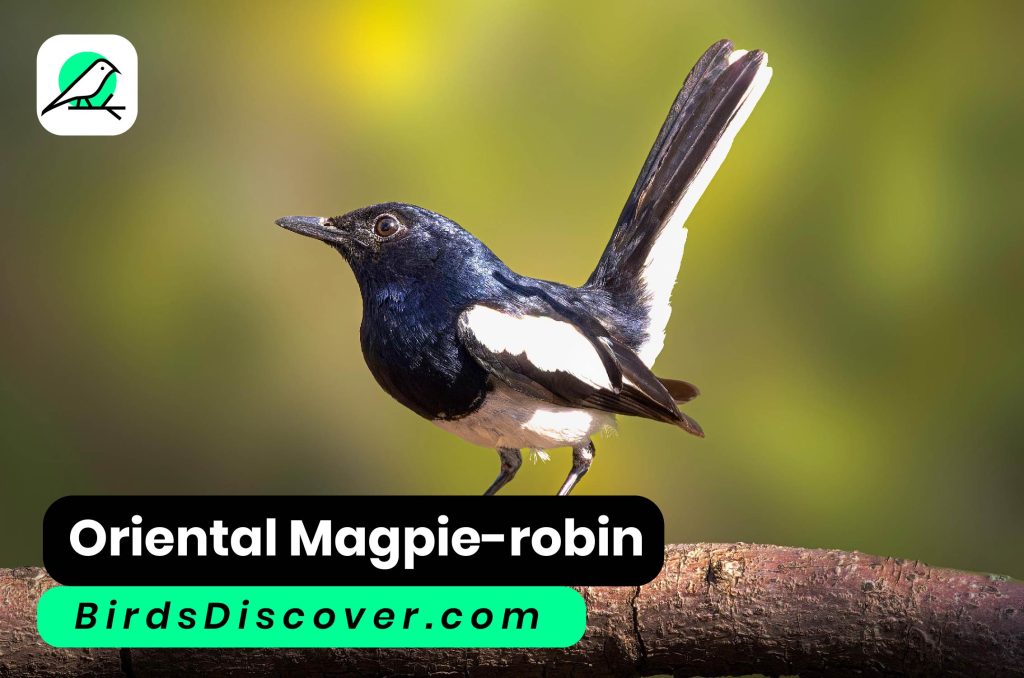
| Attribute | Description |
|---|---|
| Scientific Name | Copsychus saularis |
| Common Name | Oriental Magpie-Robin |
| Family | Muscicapidae |
| Habitat | Forests, gardens, urban areas across South and Southeast Asia |
| Diet | Insects, earthworms, small reptiles, and fruits |
| Breeding Season | February to August |
| Nest Location | Cavities in trees, walls, and buildings, often lined with grass and leaves |
| Adult Plumage | Males: Black and white; Females: Grayish-black and white |
| Juvenile Plumage | Brownish with spotted chest |
| Social Structure | Generally solitary or seen in pairs |
| Conservation Status | Least Concern (IUCN) |
| Notable Behavior | Known for their melodious song and mimicry |
| Call | Varied, melodious song often used to defend territory and attract mates |
5. Magpie-Lark
The Magpie-Lark (Grallina cyanoleuca) is a striking and adaptable bird native to eastern Australia, including open woodlands, parks, urban areas, and grasslands. Known for its distinctive black and white plumage, the Magpie-Lark features notable white wing patches and a black mask that enhances its striking appearance. As a member of the Grallidae family, this species is recognized for its distinctive call, which sounds like a harsh “pee pee” and is used for communication and marking territory. The Magpie-Lark primarily feeds on insects, worms, and small invertebrates. During the breeding season, which occurs from August to January, it builds its nest in trees, shrubs, or on man-made structures, often near water sources. Highly social, the Magpie-Lark is commonly seen in pairs or small groups and occasionally forms larger flocks. Despite its widespread presence, the Magpie-Lark is classified as Least Concern by the IUCN, reflecting a stable population. Its distinctive vocalizations and adaptable nature make it a prominent and familiar species across its range.
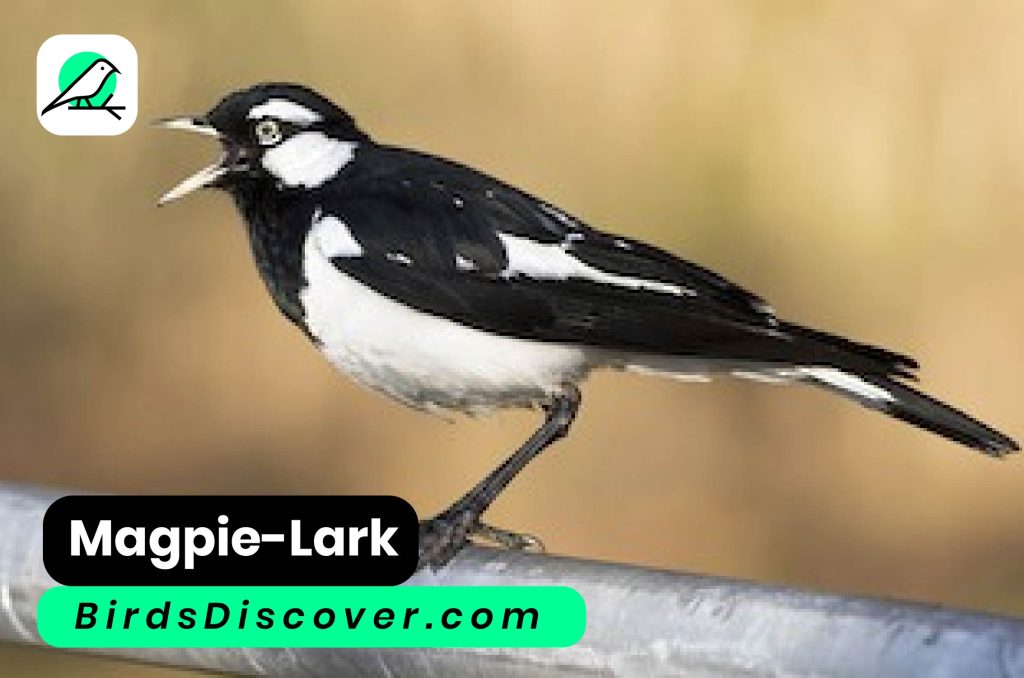
| Attribute | Description |
|---|---|
| Scientific Name | Grallina cyanoleuca |
| Common Name | Magpie-Lark |
| Family | Grallidae |
| Habitat | Open woodlands, parks, urban areas, and grasslands in eastern Australia |
| Diet | Insects, worms, and small invertebrates |
| Breeding Season | August to January |
| Nest Location | Nests are built in trees, shrubs, or on man-made structures, often near water |
| Adult Plumage | Black and white with distinctive white wing patches and a black mask |
| Juvenile Plumage | Brownish with less distinct markings |
| Social Structure | Often seen in pairs or small groups, sometimes forming larger flocks |
| Conservation Status | Least Concern (IUCN) |
| Notable Behavior | Known for their distinctive call, cooperative breeding, and territorial behavior |
| Call | A harsh, distinctive “pee pee” sound used for communication and marking territory |
6. Swamp Boubou
The Swamp Boubou (Laniarius bicolor) is an intriguing bird native to the swamps, marshes, and dense, wet woodlands of central and eastern Africa. As a member of the Malaconotidae family, this species is distinguished by its striking plumage: males feature a dramatic combination of black with white underparts and a reddish-brown back, while females exhibit more subdued colors. The Swamp Boubou is known for its melodious calls, which are used for communication and territorial displays. It primarily feeds on insects, small vertebrates, and fruit, thriving in its wetland habitat. During the breeding season, typically coinciding with the rainy period, the Swamp Boubou constructs its nest in dense vegetation or shrubs, often near water sources. Despite its specialized habitat, the Swamp Boubou is classified as Least Concern by the IUCN, indicating a stable population. Its melodious song and distinctive appearance make it a notable and fascinating species within its range.

| Attribute | Description |
|---|---|
| Scientific Name | Laniarius bicolor |
| Common Name | Swamp Boubou |
| Family | Malaconotidae |
| Habitat | Swamps, marshes, and dense, wet woodlands in central and eastern Africa |
| Diet | Insects, small vertebrates, and fruit |
| Breeding Season | Typically during the rainy season |
| Nest Location | Nests are often built in dense vegetation or shrubs, usually near water |
| Adult Plumage | Males: Black with white underparts and a reddish-brown back; Females: More subdued colors |
| Juvenile Plumage | Similar to females but with less distinct markings |
| Social Structure | Often found in pairs or small groups, occasionally forming larger flocks |
| Conservation Status | Least Concern (IUCN) |
| Notable Behavior | Known for their melodious calls and territorial displays |
| Call | A series of melodious and varied calls used for communication |
7. Black and White Warbler
The Black-and-white Warbler (Mniotilta varia) is a striking bird native to the deciduous and mixed forests of eastern North America, where it breeds during the spring and summer months. This member of the Parulidae family is notable for its distinctive black-and-white striped plumage and white belly. During the breeding season, the Black-and-white Warbler can be seen foraging on tree trunks and branches in a manner similar to nuthatches, using its unique climbing ability to search for insects, spiders, and other small invertebrates. As the seasons change, it migrates to tropical forests in Central America and the northern Andes for the winter. The Black-and-white Warbler builds its nest on the ground or low in shrubs and trees, often hidden among the foliage. Despite its specialized habitat and migratory behavior, the species is classified as Least Concern by the IUCN, indicating a stable population. Its distinctive appearance and behavior make it a notable and fascinating species within its range.

| Attribute | Description |
|---|---|
| Scientific Name | Mniotilta varia |
| Common Name | Black-and-white Warbler |
| Family | Parulidae |
| Habitat | Deciduous and mixed forests in eastern North America during the breeding season, migrating to tropical forests in Central America and the northern Andes for winter |
| Diet | Insects, spiders, and other small invertebrates |
| Breeding Season | April to July |
| Nest Location | Nests are typically built on the ground or low in shrubs and trees |
| Adult Plumage | Males and females: Black-and-white striped body with a distinctive white belly |
| Juvenile Plumage | Similar to adults but slightly duller |
| Social Structure | Generally solitary or seen in small groups during migration |
| Conservation Status | Least Concern (IUCN) |
| Notable Behavior | Known for its distinctive foraging behavior, climbing tree trunks and branches like a nuthatch |
| Call | A series of sharp, high-pitched notes often described as “weez-weez-weez” |
8. White Winged Black-Tit
The White-Winged Black-Tit (Melaniparus leuconotus) is a distinctive bird found in the forests, woodlands, and scrublands of Africa, particularly in East and Central Africa. A member of the Paridae family, this species is easily recognized by its striking black plumage contrasted with white wing patches and a white belly. The White-Winged Black-Tit primarily feeds on insects, spiders, seeds, and small fruits, showcasing its adaptability in diverse habitats. During the breeding season, which varies by region and generally coincides with the rainy season, it constructs nests in tree cavities or among dense foliage. This species is often seen in small, mixed-species foraging groups, and is known for its acrobatic foraging behavior and varied vocalizations. Despite its specialized habitat and behavior, the White-Winged Black-Tit is classified as Least Concern by the IUCN, indicating a stable population. Its unique appearance and active lifestyle make it a notable and engaging species within its range.
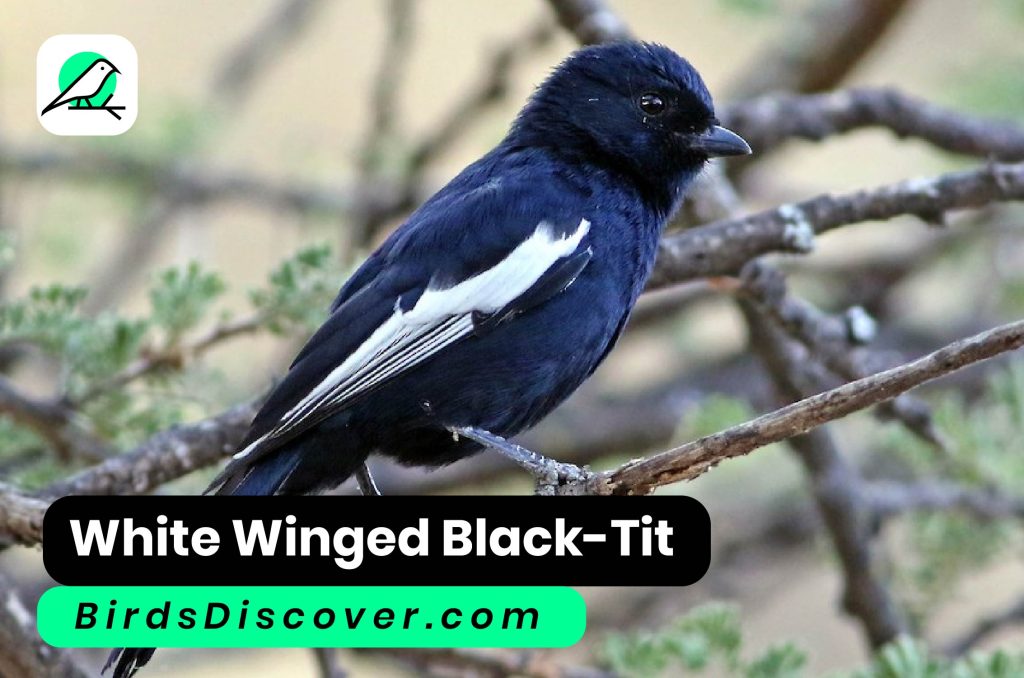
| Attribute | Description |
|---|---|
| Scientific Name | Melaniparus leuconotus |
| Common Name | White-Winged Black-Tit |
| Family | Paridae |
| Habitat | Forests, woodlands, and scrublands in Africa, particularly in regions like East and Central Africa |
| Diet | Insects, spiders, seeds, and small fruits |
| Breeding Season | Varies by region; generally during the rainy season |
| Nest Location | Nests are built in tree cavities or among dense foliage |
| Adult Plumage | Males and females: Black with distinctive white wing patches and a white belly |
| Juvenile Plumage | Similar to adults but with less defined markings |
| Social Structure | Often seen in small, mixed-species foraging groups |
| Conservation Status | Least Concern (IUCN) |
| Notable Behavior | Known for their acrobatic foraging and vocalizations |
| Call | High-pitched, varied calls often used for communication and maintaining group cohesion |
9. Northern Mockingbird
The Northern Mockingbird (Mimus polyglottos) is a fascinating and adaptable bird found across North America, from urban areas to open woodlands and scrublands. As a member of the Mimidae family, it is renowned for its exceptional vocal mimicry, capable of imitating the songs and calls of other birds, animals, and even mechanical noises. This grayish-brown bird features white wing bars and tail spots, making it easily recognizable. The Northern Mockingbird primarily feeds on insects, fruits, seeds, and small invertebrates, reflecting its omnivorous diet. During the breeding season, which spans from March to August, it builds nests in shrubs, trees, or occasionally on man-made structures. Typically solitary or found in pairs during the breeding season, Northern Mockingbirds can form loose flocks in winter. Despite its varied and often noisy vocalizations, the species is classified as Least Concern by the IUCN, indicating a stable population. Its remarkable ability to mimic sounds and its adaptability to diverse environments make the Northern Mockingbird a notable and intriguing species.
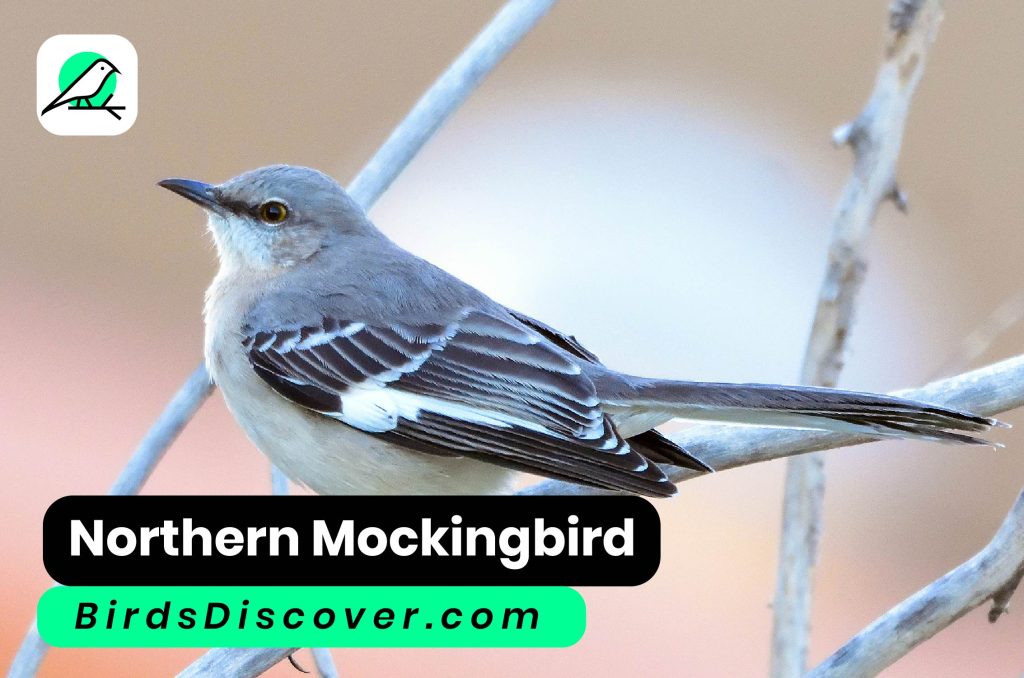
| Attribute | Description |
|---|---|
| Scientific Name | Mimus polyglottos |
| Common Name | Northern Mockingbird |
| Family | Mimidae |
| Habitat | Varied, including urban areas, open woodlands, and scrublands across North America |
| Diet | Insects, fruits, seeds, and small invertebrates |
| Breeding Season | March to August |
| Nest Location | Nests are built in shrubs, trees, and occasionally on man-made structures |
| Adult Plumage | Grayish-brown body with white wing bars and tail spots |
| Juvenile Plumage | Similar to adults but with more muted colors and less defined markings |
| Social Structure | Generally solitary or found in pairs during breeding season; can form loose flocks in winter |
| Conservation Status | Least Concern (IUCN) |
| Notable Behavior | Renowned for its vocal mimicry, able to imitate the songs and calls of other birds, animals, and even mechanical noises |
| Call | A diverse range of sounds including whistles, squawks, and imitations of other species |
10. Anhinga
The Anhinga (Anhinga anhinga) is a striking water bird native to freshwater lakes, rivers, and swamps throughout the Americas, particularly in the southeastern United States, Central America, and northern South America. Often referred to as the “snakebird” due to its long, slender neck and head, the Anhinga is a member of the Anhingidae family. This bird is renowned for its distinctive swimming and diving technique, where it glides through the water with only its neck and head exposed. The adult male Anhinga is characterized by its black plumage with white wings and a long, sharp beak, while the female is similarly plumaged but with less contrast. Juveniles are more brownish and less striking than adults. Anhingas primarily feed on fish, but they also eat amphibians and small reptiles. During the breeding season, which varies by region, they build nests in trees or large shrubs near water. Despite their distinctive appearance and behavior, Anhingas are classified as Least Concern by the IUCN, indicating a stable population. Their unique foraging method and adaptability to aquatic environments make them a notable species in their habitat.

| Attribute | Description |
|---|---|
| Scientific Name | Anhinga anhinga |
| Common Name | Anhinga |
| Family | Anhingidae |
| Habitat | Freshwater lakes, rivers, and swamps in the Americas, particularly in the southeastern United States, Central America, and northern South America |
| Diet | Primarily fish, but also amphibians and small reptiles |
| Breeding Season | Varies by region; generally during the warmer months |
| Nest Location | Nests are built in trees or large shrubs, often near water |
| Adult Plumage | Males: Black with white wings and a distinctive long, slender neck; Females: Similar but with less contrast in plumage |
| Juvenile Plumage | Duller and more brownish compared to adults |
| Social Structure | Often seen alone or in small groups; can form larger groups at roosting sites |
| Conservation Status | Least Concern (IUCN) |
| Notable Behavior | Known for its unique swimming and diving technique, where it often swims with only its neck and head above water |
| Call | Generally silent, but may produce soft, croaking calls during the breeding season |
11. White-browed Wagtail
The White-browed Wagtail (Motacilla maderaspatensis) is a charming and distinctive bird native to South Asia, including regions such as India, Pakistan, and Sri Lanka. As a member of the Motacillidae family, this species is notable for its striking appearance: males have a predominantly white body with a black crown, throat, and upperparts, while females are similarly patterned but with less pronounced contrast. This wagtail is commonly found in open areas, grasslands, and near water bodies, where it forages for insects, small invertebrates, and occasionally seeds. During the breeding season, which typically runs from March to August, White-browed Wagtails build their nests in shrubs, tall grass, or low vegetation. They are often seen in pairs or small groups, and their lively, agile movements are complemented by a characteristic wagging tail. Despite its vibrant appearance and active behavior, the White-browed Wagtail is classified as Least Concern by the IUCN, indicating a stable population. Its melodious call and engaging presence make it a notable species within its habitat.
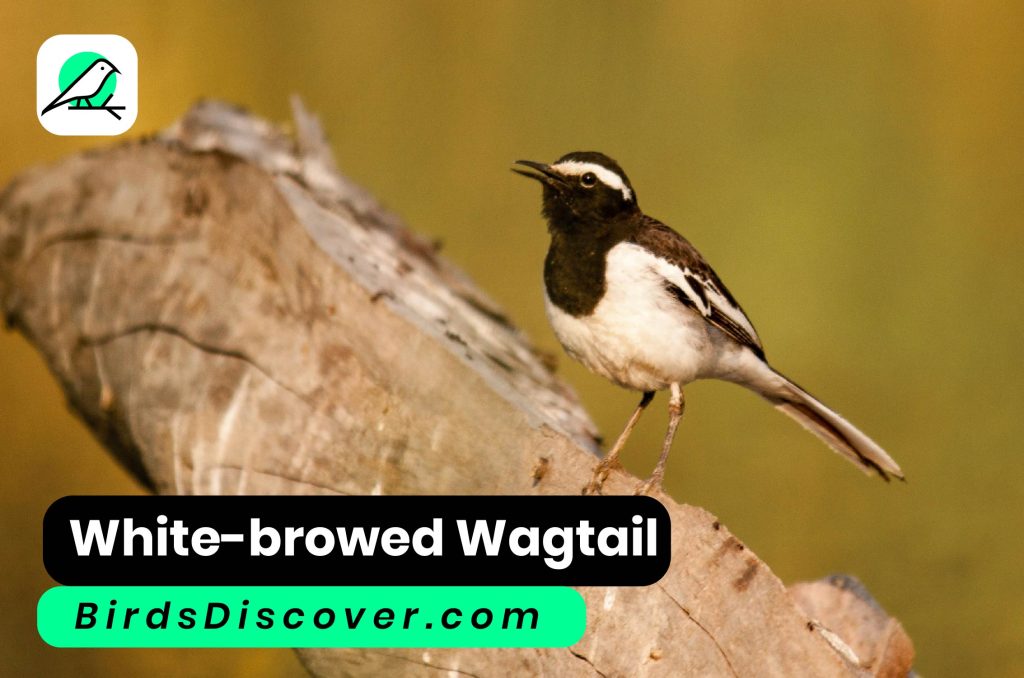
| Attribute | Description |
|---|---|
| Scientific Name | Motacilla maderaspatensis |
| Common Name | White-browed Wagtail |
| Family | Motacillidae |
| Habitat | Found in open areas, grasslands, and near water bodies in South Asia, including India, Pakistan, and Sri Lanka |
| Diet | Insects, small invertebrates, and occasionally seeds |
| Breeding Season | Typically from March to August |
| Nest Location | Nests are built in shrubs, tall grass, or low vegetation |
| Adult Plumage | Males: White with a distinctive black crown, throat, and upperparts; Females: Similar but often with less contrast |
| Juvenile Plumage | Duller and more streaked compared to adults |
| Social Structure | Often seen in pairs or small groups; can be solitary outside of breeding season |
| Conservation Status | Least Concern (IUCN) |
| Notable Behavior | Known for its characteristic wagging tail and agile, lively movements |
| Call | A soft, melodious call often described as “chee-chee” or “chwee-chwee” |
12. White-Winged Scoter
The White-Winged Scoter (Melanitta deglandi) is a striking sea duck found in the northern regions of North America and Eurasia. This member of the Anatidae family is easily identified by its distinctive appearance: males have a predominantly black body with white wing patches and a bright orange bill, while females are more muted, featuring a brownish body with pale undersides. During the breeding season, which typically spans from May to July, the White-Winged Scoter nests on the ground near water, often in dense vegetation or under shrubs. Its diet primarily consists of mollusks, crustaceans, and small fish, reflecting its preference for coastal and estuarine environments. Outside the breeding season, the White-Winged Scoter migrates to more temperate coastal areas, where it often forms large flocks. Known for its excellent diving abilities and deep-water foraging, this species is a notable part of the coastal avifauna. Despite its specialized habitat and migratory behavior, the White-Winged Scoter is classified as Least Concern by the IUCN, indicating a stable population.

| Attribute | Description |
|---|---|
| Scientific Name | Melanitta deglandi |
| Common Name | White-Winged Scoter |
| Family | Anatidae |
| Habitat | Coastal waters, estuaries, and lakes in northern regions of North America and Eurasia; migrates to more temperate coastal areas during winter |
| Diet | Primarily feeds on mollusks, crustaceans, and small fish |
| Breeding Season | May to July |
| Nest Location | Nests are built on the ground near water, often in dense vegetation or under shrubs |
| Adult Plumage | Males: Black with white wing patches and a distinctive orange bill; Females: Brownish with pale undersides |
| Juvenile Plumage | Similar to females but with more muted colors |
| Social Structure | Often found in flocks, especially during migration and winter |
| Conservation Status | Least Concern (IUCN) |
| Notable Behavior | Known for its diving ability and foraging behavior in deep water |
| Call | A variety of low-pitched, whistling, and grunting sounds |
13. White-headed Woodpecker
The White-headed Woodpecker (Picoides albolarvatus) is a distinctive bird native to the coniferous and mixed forests of western North America, particularly in mountainous regions. Recognizable by its striking plumage, the male White-headed Woodpecker features a white head contrasted with a black body and white wing patches, while the female’s white head is less pronounced. This member of the Picidae family primarily feeds on insects such as beetles, ants, and larvae, as well as some tree sap. During the breeding season, which typically spans from April to July, the White-headed Woodpecker excavates its nest in dead or decaying trees, often opting for large cavities. Known for its distinctive drumming and foraging behavior on trees, this woodpecker is generally solitary or found in pairs, with occasional sightings in small groups outside the breeding season. Despite its specialized habitat, the White-headed Woodpecker is classified as Least Concern by the IUCN, indicating a stable population. Its unique appearance and behavior make it a notable species within its forested environment.

| Attribute | Description |
|---|---|
| Scientific Name | Picoides albolarvatus |
| Common Name | White-headed Woodpecker |
| Family | Picidae |
| Habitat | Coniferous and mixed forests in western North America, particularly in mountainous regions |
| Diet | Primarily insects, including beetles, ants, and larvae, as well as some tree sap |
| Breeding Season | April to July |
| Nest Location | Nests are typically excavated in dead or decaying trees, often in large cavities |
| Adult Plumage | Males: White head with a black body and white wing patches; Females: Similar but with less pronounced white on the head |
| Juvenile Plumage | Similar to adults but with more subdued colors and less defined markings |
| Social Structure | Generally solitary or found in pairs; can be seen in small groups outside the breeding season |
| Conservation Status | Least Concern (IUCN) |
| Notable Behavior | Known for its distinctive drumming and foraging behavior on trees |
| Call | A series of sharp, rhythmic drumming sounds and distinctive calls |
14. Downy Woodpecker
The Downy Woodpecker (Picoides pubescens) is a small and charming bird native to North America, commonly found in deciduous and mixed forests as well as suburban and urban areas. As a member of the Picidae family, the Downy Woodpecker is characterized by its distinctive plumage: it has a white underside with a black and white patterned back, and males feature a small red patch on the back of the head. This woodpecker primarily feeds on insects such as beetles, ants, and larvae, though it also consumes tree sap and seeds. During the breeding season, which spans from March to July, the Downy Woodpecker excavates its nest in dead or decaying trees, sometimes repurposing old nests of other woodpeckers. Known for its rapid drumming on trees and its foraging behavior on small branches and twigs, the Downy Woodpecker is often seen alone or in pairs, with the possibility of forming small flocks in winter. Despite its widespread distribution and varied diet, the Downy Woodpecker is classified as Least Concern by the IUCN, reflecting a stable population. Its distinctive appearance and active foraging make it a notable and engaging species within its range.

| Attribute | Description |
|---|---|
| Scientific Name | Picoides pubescens |
| Common Name | Downy Woodpecker |
| Family | Picidae |
| Habitat | Deciduous and mixed forests, as well as suburban and urban areas across North America |
| Diet | Primarily insects, including beetles, ants, and larvae, as well as some tree sap and seeds |
| Breeding Season | March to July |
| Nest Location | Nests are excavated in dead or decaying trees, sometimes using old nests of other woodpeckers |
| Adult Plumage | Males and females: White undersides with black and white patterned back; males have a small red patch on the back of the head |
| Juvenile Plumage | Similar to adults but with more subdued colors and less contrast |
| Social Structure | Often seen alone or in pairs; can form small flocks in winter |
| Conservation Status | Least Concern (IUCN) |
| Notable Behavior | Known for its rapid drumming on trees and frequent foraging on small branches and twigs |
| Call | A series of sharp, high-pitched “pik” calls and drumming sounds |
15. Bar-Winged Flycatcher-Shrike
The Bar-winged Flycatcher-shrike (Hemipus picatus) is a captivating bird native to the forest edges, open woodlands, and scrublands of South and Southeast Asia, including regions such as India, Sri Lanka, and Myanmar. As a member of the Laniidae family, this species is known for its distinctive appearance and behavior. The adult male Bar-winged Flycatcher-shrike has blackish upperparts with striking white wing bars and a pale belly, while the female is similarly patterned but often with less contrast. Juveniles are more subdued in coloration, with brownish tones. The bird primarily feeds on insects and other small invertebrates, foraging actively in its forest habitat. During the breeding season, which generally runs from March to August, it constructs its nest in trees or shrubs, often well-hidden among the foliage. Outside the breeding season, it can be seen in pairs or small groups and sometimes forms loose flocks. Despite its specialized habitat, the Bar-winged Flycatcher-shrike is classified as Least Concern by the IUCN, reflecting a stable population. Its distinctive calls and active foraging behavior make it a notable species within its

| Attribute | Description |
|---|---|
| Scientific Name | Hemipus picatus |
| Common Name | Bar-winged Flycatcher-shrike |
| Family | Laniidae |
| Habitat | Forest edges, open woodlands, and scrublands in South and Southeast Asia, including parts of India, Sri Lanka, and Myanmar |
| Diet | Insects and other small invertebrates |
| Breeding Season | Generally from March to August |
| Nest Location | Nests are built in trees or shrubs, often well-hidden among the foliage |
| Adult Plumage | Males: Blackish upperparts with white wing bars and a pale belly; Females: Similar but often with less contrast |
| Juvenile Plumage | Duller and more brownish compared to adults |
| Social Structure | Typically seen in pairs or small groups; can form loose flocks outside the breeding season |
| Conservation Status | Least Concern (IUCN) |
| Notable Behavior | Known for its active foraging and distinctive calls |
| Call | A series of sharp, high-pitched calls often described as “pee-pee-pee” |
16. White-Winged Widowbird
The White-Winged Widowbird (Euplectes albonotatus) is a striking and vibrant bird found in the grasslands, savannas, and open areas of eastern and southern Africa. Known for its dramatic plumage, the male White-Winged Widowbird is characterized by its black body adorned with striking white wing patches and a distinctive red or orange shoulder patch. In contrast, females are more subdued in appearance, with brown and streaked plumage. This member of the Ploceidae family primarily feeds on seeds, insects, and other small invertebrates. During the breeding season, which typically runs from October to January, males engage in elaborate courtship displays and vocalizations to attract females, and they build nests in tall grass or reeds, often within dense colonies. Outside the breeding season, White-Winged Widowbirds are commonly seen in large, noisy flocks. Despite its specialized breeding behavior and habitat preferences, the White-Winged Widowbird is classified as Least Concern by the IUCN, indicating a stable population. Its striking appearance and elaborate courtship rituals make it a notable species within its range.
| Attribute | Description |
|---|---|
| Scientific Name | Euplectes albonotatus |
| Common Name | White-Winged Widowbird |
| Family | Ploceidae |
| Habitat | Grasslands, savannas, and open areas in eastern and southern Africa |
| Diet | Seeds, insects, and other small invertebrates |
| Breeding Season | Typically from October to January |
| Nest Location | Nests are built in tall grass or reeds, often in dense colonies |
| Adult Plumage | Males: Black with striking white wing patches and a distinctive red or orange shoulder patch; Females: Brown and streaked, more subdued in color |
| Juvenile Plumage | Similar to females but may have slightly different patterns |
| Social Structure | Often seen in large, noisy flocks, especially outside the breeding season |
| Conservation Status | Least Concern (IUCN) |
| Notable Behavior | Known for its elaborate courtship displays and vocalizations during the breeding season |
| Call | A variety of chirps and whistles, often used in mating displays |
17. White-Winged Triller
The White-Winged Triller (Lalage sueurii) is an attractive and lively bird found in open woodlands, savannas, and forest edges across tropical Africa. This member of the Campephagidae family is known for its distinctive appearance: the male White-Winged Triller has a striking black head, white wings, and a contrasting pale belly, while the female’s colors are more subdued. Juveniles exhibit a duller, more brownish plumage compared to adults. The White-Winged Triller primarily feeds on insects, small fruits, and seeds. During the breeding season, which typically occurs from October to February, it constructs nests in shrubs or low trees, often well-hidden among the foliage. Outside the breeding period, the White-Winged Triller can be seen in pairs or small groups and sometimes forms larger flocks. Known for its melodious calls and active foraging behavior, this bird is classified as Least Concern by the IUCN, indicating a stable population. Its distinctive calls and vibrant plumage make the White-Winged Triller a notable and engaging species within its habitat.

| Attribute | Description |
|---|---|
| Scientific Name | Lalage sueurii |
| Common Name | White-Winged Triller |
| Family | Campephagidae |
| Habitat | Open woodlands, savannas, and forest edges in tropical regions of Africa |
| Diet | Insects, small fruits, and seeds |
| Breeding Season | Typically from October to February |
| Nest Location | Nests are built in shrubs or low trees, often well-hidden among the foliage |
| Adult Plumage | Males: Black head, white wings, and a contrasting pale belly; Females: Similar but with more muted colors |
| Juvenile Plumage | Duller and more brownish compared to adults |
| Social Structure | Often seen in pairs or small groups; can form larger flocks outside the breeding season |
| Conservation Status | Least Concern (IUCN) |
| Notable Behavior | Known for its distinctive calls and active foraging behavior |
| Call | A variety of melodious calls, often described as “trill” or “cheer-up” |
18. Mountain Wheatear
The Mountain Wheatear (Oenanthe monticola) is a striking bird native to the rocky and alpine regions of Central and South Asia. As a member of the Muscicapidae family, this species is well adapted to high-altitude environments, often inhabiting open mountainous regions and high-altitude grasslands. The male Mountain Wheatear is particularly notable for its pale gray plumage above, contrasted by a white belly and a distinctive black face, while the female’s coloration is similar but with less contrast. Juveniles are more subdued, with streaked plumage. The bird primarily feeds on insects, small invertebrates, and occasionally fruits. During the breeding season, from May to August, it nests in crevices, rocky ledges, or on the ground in sheltered spots. The Mountain Wheatear is often seen alone or in pairs, with the possibility of forming small groups outside of breeding season. Known for its perch-and-pounce hunting technique and melodious song, the Mountain Wheatear is classified as Least Concern by the IUCN, indicating a stable population. Its distinctive appearance and behavior make it a notable species within its high

| Attribute | Description |
|---|---|
| Scientific Name | Oenanthe monticola |
| Common Name | Mountain Wheatear |
| Family | Muscicapidae |
| Habitat | Rocky and alpine areas, open mountainous regions, and high-altitude grasslands in Central and South Asia |
| Diet | Insects, small invertebrates, and occasionally fruits |
| Breeding Season | Typically from May to August |
| Nest Location | Nests are built in crevices, rocky ledges, or on the ground in sheltered spots |
| Adult Plumage | Males: Pale gray above with a white belly and a contrasting black face; Females: Similar but with less contrast |
| Juvenile Plumage | Duller and more streaked compared to adults |
| Social Structure | Usually seen alone or in pairs; can form small groups outside the breeding season |
| Conservation Status | Least Concern (IUCN) |
| Notable Behavior | Known for its perch-and-pounce hunting technique and melodious song |
| Call | A series of clear, melodious notes and calls often described as “chee-chee-chee” |
19. White-shouldered Fire-eye
The White-shouldered Fire-eye (Pyrocephalus rubinus) is a vibrant and eye-catching bird native to the open woodlands, savannas, and forest edges of Central and South America, with a notable presence in Brazil and Bolivia. This member of the Tyrannidae family is distinguished by its striking appearance: the male boasts a bright red body with contrasting black wings and distinctive white shoulders, while the female’s colors are more subdued yet still distinctive. Juveniles are characterized by their duller, streaked plumage. The White-shouldered Fire-eye primarily feeds on insects, small invertebrates, and some fruits, foraging actively in its open or semi-open habitat. During the breeding season, which spans from September to March, it builds its nest in trees or shrubs, often in exposed areas. Typically seen in pairs or small family groups, this species can also form larger flocks outside the breeding period. Known for its distinctive calls and dynamic behavior, the White-shouldered Fire-eye is classified as Least Concern by the IUCN, reflecting a stable population. Its vivid plumage and lively calls make it a notable and engaging species within its range.

| Attribute | Description |
|---|---|
| Scientific Name | Pyrocephalus rubinus |
| Common Name | White-shouldered Fire-eye |
| Family | Tyrannidae |
| Habitat | Open woodlands, savannas, and edges of forests in Central and South America, particularly in Brazil and Bolivia |
| Diet | Insects, small invertebrates, and some fruits |
| Breeding Season | Typically from September to March |
| Nest Location | Nests are built in trees or shrubs, often in open or semi-open areas |
| Adult Plumage | Males: Bright red body with black wings and white shoulders; Females: Similar but with more subdued colors |
| Juvenile Plumage | Duller and more streaked compared to adults |
| Social Structure | Often seen in pairs or small family groups; can form larger flocks outside the breeding season |
| Conservation Status | Least Concern (IUCN) |
| Notable Behavior | Known for its distinctive calls and active foraging behavior |
| Call | A variety of sharp, high-pitched calls often described as “pee-pee-pee” |
20. Black Guillemot
The Black Guillemot (Cepphus grylle) is a distinctive seabird native to the northern Atlantic, inhabiting coastal cliffs, rocky shores, and islands across regions such as North America, Greenland, Iceland, and Europe. As a member of the Alcidae family, this species is easily recognizable by its striking plumage: the male has a black body adorned with white wing patches and a red or orange bill, while the female’s colors are more subdued but similar. Juveniles are more mottled and less vibrant than adults. The Black Guillemot primarily feeds on fish, such as herring and sand eels, as well as some crustaceans. During the breeding season, which spans from May to July, it nests in crevices or on rocky ledges, often in dense colonies. Outside of the breeding period, the Black Guillemot can be found in smaller groups or alone. Known for its impressive diving skills and vocalizations, particularly during the breeding season, the Black Guillemot is classified as Least Concern by the IUCN, reflecting a stable population. Its distinctive appearance and behaviors make it a notable and engaging species within its northern habitat.

| Attribute | Description |
|---|---|
| Scientific Name | Cepphus grylle |
| Common Name | Black Guillemot |
| Family | Alcidae |
| Habitat | Coastal cliffs, rocky shores, and islands in the northern Atlantic, including parts of North America, Greenland, Iceland, and Europe |
| Diet | Primarily fish, such as herring and sand eels, as well as some crustaceans |
| Breeding Season | Generally from May to July |
| Nest Location | Nests are built in crevices or on rocky ledges, often in colonies |
| Adult Plumage | Males: Black body with white wing patches and a red or orange bill; Females: Similar but less vibrant |
| Juvenile Plumage | Duller and more mottled compared to adults |
| Social Structure | Often seen in breeding colonies; outside of the breeding season, they can be found in smaller groups or alone |
| Conservation Status | Least Concern (IUCN) |
| Notable Behavior | Known for its diving ability and vocalizations, particularly during the breeding season |
| Call | A variety of harsh, grating calls and whistles |
21. Tricolored Blackbird
The Tricolored Blackbird (Agelaius tricolor) is a striking bird native to the wetlands and grasslands of California and northern Mexico. As a member of the Icteridae family, this species is easily identified by the male’s vibrant plumage: a glossy black body with bold red and yellow shoulder patches. In contrast, females are more subdued in appearance, with brown and streaked feathers. Juveniles resemble females but have less defined streaking. The Tricolored Blackbird primarily forages for insects, seeds, and some berries. During the breeding season, which typically runs from April to July, it builds nests in dense reeds or cattails within wetland areas, often forming large colonies that can be quite noisy. The species is highly social, known for its aggressive territorial behavior and distinctive calls. However, the Tricolored Blackbird is currently classified as Endangered by the IUCN due to habitat loss and environmental changes affecting its wetland habitats. Despite its vibrant appearance and social nature, the species faces significant conservation challenges.

| Attribute | Description |
|---|---|
| Scientific Name | Agelaius tricolor |
| Common Name | Tricolored Blackbird |
| Family | Icteridae |
| Habitat | Freshwater marshes, wetland edges, and grasslands primarily in California, USA, and northern Mexico |
| Diet | Insects, seeds, and some berries |
| Breeding Season | Typically from April to July |
| Nest Location | Nests are built in dense reeds or cattails in wetland areas, often in large colonies |
| Adult Plumage | Males: Black with striking red and yellow shoulder patches; Females: Brown and streaked, more subdued in color |
| Juvenile Plumage | Similar to females but with less defined streaking |
| Social Structure | Highly social, often found in large, noisy colonies during the breeding season |
| Conservation Status | Endangered (IUCN) |
| Notable Behavior | Known for its large, noisy colonies and aggressive territorial behavior |
| Call | A variety of harsh, chattering calls and whistles |
22. Yellow-headed Blackbird
The Yellow-headed Blackbird (Xanthocephalus xanthocephalus) is a striking bird native to marshes, wetlands, and reed beds across North America, particularly in the western and central regions. As a member of the Icteridae family, this species is easily identifiable by the male’s vibrant yellow head and chest, contrasted with a black body. Females, in contrast, have a more subdued appearance with brown and streaked plumage. Juveniles resemble females but often show more streaking and less color contrast. The Yellow-headed Blackbird primarily feeds on insects, seeds, and some aquatic plants. During the breeding season, which typically spans from May to July, it builds its nests in tall grasses or reeds within wetland areas, often forming large, noisy colonies. Outside of the breeding season, the Yellow-headed Blackbird is generally found in smaller groups or alone. Known for its distinctive calls and aggressive territorial behavior, this species is classified as Least Concern by the IUCN, reflecting a stable population. Its vivid plumage and social behavior make it a notable and engaging species within its habitat.

| Attribute | Description |
|---|---|
| Scientific Name | Xanthocephalus xanthocephalus |
| Common Name | Yellow-headed Blackbird |
| Family | Icteridae |
| Habitat | Marshes, wetlands, and reed beds across North America, particularly in the western and central regions |
| Diet | Insects, seeds, and some aquatic plants |
| Breeding Season | Typically from May to July |
| Nest Location | Nests are built in tall grasses or reeds in wetland areas, often in colonies |
| Adult Plumage | Males: Bright yellow head and chest with a black body; Females: Brown and streaked with a more subdued appearance |
| Juvenile Plumage | Similar to females but may have more streaking and less contrast |
| Social Structure | Often seen in large, noisy colonies during the breeding season; more solitary or in small groups outside of breeding season |
| Conservation Status | Least Concern (IUCN) |
| Notable Behavior | Known for its distinctive calls and aggressive territorial behavior during the breeding season |
| Call | A variety of harsh, chattering calls and whistles |
23. Hairy Woodpecker
The Hairy Woodpecker (Picoides villosus) is a versatile and widely distributed bird native to North America, commonly found in deciduous and mixed forests, woodlands, and even urban areas. As a member of the Picidae family, this species is easily recognizable by its striking black and white plumage. The male Hairy Woodpecker features a distinctive red patch on the back of its head, while the female lacks this red marking. Juveniles resemble adults but have more subdued and brownish tones. This woodpecker primarily feeds on insects, particularly beetles and ants, as well as some seeds and fruits. During the breeding season, which typically runs from April to August, the Hairy Woodpecker excavates its nest in dead or decaying trees. Known for its distinctive drumming sound, which is used to communicate and establish territory, the Hairy Woodpecker is generally solitary or found in pairs, and can sometimes be seen in small groups outside of the breeding season. Despite its broad distribution and adaptability, it is classified as Least Concern by the IUCN, indicating a stable population. Its distinctive appearance and active foraging behavior make it a notable species within its habitat.

| Attribute | Description |
|---|---|
| Scientific Name | Picoides villosus |
| Common Name | Hairy Woodpecker |
| Family | Picidae |
| Habitat | Deciduous and mixed forests, woodlands, and sometimes urban areas throughout North America |
| Diet | Primarily insects, especially beetles and ants, as well as some seeds and fruits |
| Breeding Season | Typically from April to August |
| Nest Location | Nests are excavated in dead or dying trees, often in decayed wood |
| Adult Plumage | Males: Black and white with a red patch on the back of the head; Females: Similar but without the red patch |
| Juvenile Plumage | Similar to adults but with more brownish tones and less contrast |
| Social Structure | Generally solitary or seen in pairs; can be found in small groups outside of breeding season |
| Conservation Status | Least Concern (IUCN) |
| Notable Behavior | Known for its distinctive drumming sound and active foraging behavior |
| Call | A sharp, repetitive “peek” or “wick” sound |
24. Black-billed Magpie
The Black-billed Magpie (Pica hudsonia) is a striking bird native to open country, grasslands, and forest edges in western North America, including parts of the western United States and Canada. A member of the Corvidae family, the Black-billed Magpie is easily recognizable by its distinctive black head, back, and wings, complemented by white underparts and a long, iridescent tail. The species is omnivorous, feeding on a diverse diet that includes insects, small mammals, seeds, fruits, and carrion. During the breeding season, which typically runs from March to July, the Black-billed Magpie builds large, domed nests in trees or large shrubs. Known for its intelligence and complex social behavior, this magpie is often seen in pairs or small family groups but can form larger flocks outside the breeding season. The Black-billed Magpie is also noted for its noisy calls and distinctive vocalizations. Classified as Least Concern by the IUCN, this species maintains a stable population. Its striking appearance and social behavior make it a notable and engaging species within its habitat.
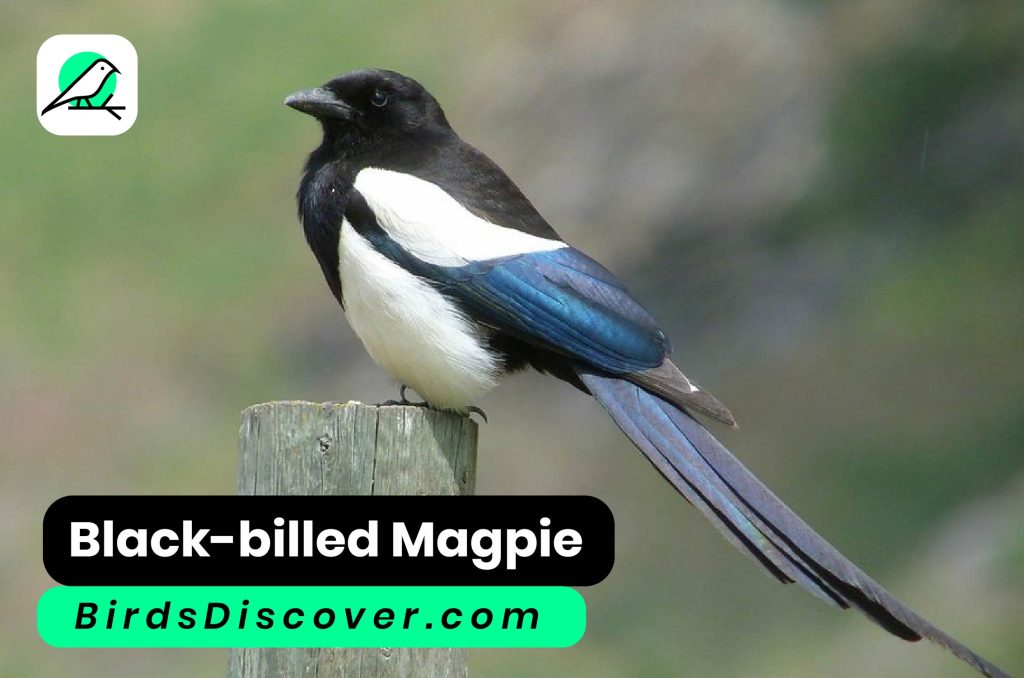
| Attribute | Description |
|---|---|
| Scientific Name | Pica hudsonia |
| Common Name | Black-billed Magpie |
| Family | Corvidae |
| Habitat | Open country, grasslands, and forest edges in western North America, including parts of the western United States and Canada |
| Diet | Omnivorous; feeds on insects, small mammals, seeds, fruits, and carrion |
| Breeding Season | Typically from March to July |
| Nest Location | Nests are built in trees or large shrubs, often in the form of large, domed structures |
| Adult Plumage | Males and females: Black head, back, and wings with white underparts and a long, iridescent tail |
| Juvenile Plumage | Duller and more mottled compared to adults |
| Social Structure | Often seen in pairs or small family groups; can form larger flocks outside the breeding season |
| Conservation Status | Least Concern (IUCN) |
| Notable Behavior | Known for its intelligence and complex social behavior, as well as its noisy calls |
| Call | A variety of harsh, chattering calls and whistles |
25. Yellow-bellied Sapsucker
The Yellow-bellied Sapsucker (Sphyrapicus varius) is a distinctive woodpecker native to deciduous and mixed forests, woodlands, and occasionally urban areas across North America. This member of the Picidae family is known for its striking plumage: both males and females feature a bright yellow belly, a red patch on the throat and crown, and a black-and-white back. Juveniles have similar patterns but with less vivid colors and more streaking. The Yellow-bellied Sapsucker primarily feeds on tree sap, creating distinctive sap wells in trees, but it also consumes insects and some fruits. During the breeding season, from April to July, it nests in live trees, excavating a cavity for its nest. Outside of the breeding period, this woodpecker is often seen in more social settings, sometimes forming small groups. Known for its distinctive drumming sound and its ability to create and maintain sap wells, the Yellow-bellied Sapsucker is classified as Least Concern by the IUCN, indicating a stable population. Its unique feeding habits and vibrant appearance make it a notable species within its habitat.

| Attribute | Description |
|---|---|
| Scientific Name | Sphyrapicus varius |
| Common Name | Yellow-bellied Sapsucker |
| Family | Picidae |
| Habitat | Deciduous and mixed forests, woodlands, and sometimes in urban areas across North America |
| Diet | Primarily feeds on tree sap, but also insects and some fruits |
| Breeding Season | Typically from April to July |
| Nest Location | Nests are excavated in live trees, often in a cavity made by the bird itself |
| Adult Plumage | Males and females: Distinctive yellow belly with a red patch on the throat and crown, black and white back |
| Juvenile Plumage | Similar to adults but with less vivid colors and more streaking |
| Social Structure | Generally solitary or seen in pairs during the breeding season; more social outside of breeding season |
| Conservation Status | Least Concern (IUCN) |
| Notable Behavior | Known for its distinctive drumming sound and sap wells on trees |
| Call | A variety of drumming sounds and sharp, high-pitched calls |
26. Black Phoebe
The Black Phoebe (Sayornis nigricans) is a striking and adaptable bird native to open areas near water, including rivers, streams, and urban environments throughout western North America and parts of Central America. As a member of the Tyrannidae family, the Black Phoebe is easily recognized by its black upperparts and white belly, with distinct white edges on its tail. Juveniles are more subdued, with streaked plumage that gradually brightens to the adult’s vivid coloration. This flycatcher primarily feeds on insects, such as flies, beetles, and moths, though it will also consume small fruits occasionally. During the breeding season, which typically spans from March to August, it nests in a variety of locations, including ledges, under bridges, and in buildings, as well as on natural cliff faces. Known for its distinctive sallying flight to catch prey and its high-pitched “pee pee pee” call, the Black Phoebe is generally solitary or seen in pairs during the breeding season but can form small groups outside of it. Classified as Least Concern by the IUCN, the Black Phoebe maintains a stable population. Its adaptable nature and distinctive behaviors make it a notable species within its habitat.

| Attribute | Description |
|---|---|
| Scientific Name | Sayornis nigricans |
| Common Name | Black Phoebe |
| Family | Tyrannidae |
| Habitat | Open areas near water, including rivers, streams, and urban areas, throughout western North America and parts of Central America |
| Diet | Primarily insects, including flies, beetles, and moths; occasionally small fruits |
| Breeding Season | Typically from March to August |
| Nest Location | Nests are often built on ledges, under bridges, or in buildings; can also be found on natural cliff faces |
| Adult Plumage | Males and females: Black upperparts with a white belly and contrasting white edges on the tail |
| Juvenile Plumage | Duller and more streaked compared to adults |
| Social Structure | Generally solitary or seen in pairs during the breeding season; can form small groups outside of breeding season |
| Conservation Status | Least Concern (IUCN) |
| Notable Behavior | Known for its distinctive, sallying flight to catch insects and its characteristic “pee pee pee” call |
| Call | A high-pitched, repetitive “pee pee pee” sound |
27. Common Nighthawk
The Common Nighthawk (Chordeiles minor) is a distinctive bird known for its nocturnal habits and unique appearance. Native to open areas such as grasslands, deserts, and urban environments across North and Central America, this member of the Nightjar family is recognized by its cryptic plumage, which features mottled brown, gray, and black feathers that provide excellent camouflage against its surroundings. The Common Nighthawk primarily feeds on insects, including moths, beetles, and flies, which it catches in mid-flight using its wide mouth and agile flying patterns. During the breeding season, from May to August, it nests on the ground or flat surfaces, often in open or gravelly areas where its camouflage helps protect it from predators. Known for its distinctive “booming” call made during flight displays and its erratic, moth-like flight patterns, the Common Nighthawk is generally solitary or seen in pairs but can form small groups during migration. Despite its elusive nature, it is classified as Least Concern by the IUCN, indicating a stable population. Its unique behaviors and adaptations make it a fascinating species within its habitat.

| Attribute | Description |
|---|---|
| Scientific Name | Chordeiles minor |
| Common Name | Common Nighthawk |
| Family | Nightjars (Caprimulgidae) |
| Habitat | Open areas such as grasslands, deserts, and urban areas across North and Central America |
| Diet | Primarily insects, including moths, beetles, and flies |
| Breeding Season | Typically from May to August |
| Nest Location | Nests on the ground or on flat surfaces, often in open or gravelly areas |
| Adult Plumage | Males and females: Camouflaged plumage with mottled brown, gray, and black; white throat and wing patches |
| Juvenile Plumage | Similar to adults but with more subdued colors and less defined patterns |
| Social Structure | Generally solitary or seen in pairs; can form small groups during migration |
| Conservation Status | Least Concern (IUCN) |
| Notable Behavior | Known for its distinctive “booming” call during flight and erratic, moth-like flying patterns |
| Call | A characteristic “boom” sound made during display flights |
28. Dot-winged Antwren
The Dot-winged Antwren (Microrhopias quixotes) is a charming and elusive bird native to the lowland and foothill forests of the Amazon Basin, as well as parts of the Guianas and Brazil. A member of the Thamnidae family, this species is known for its distinctive appearance, with males exhibiting olive-green upperparts adorned with striking black spots on their wings, while females have a more subdued, less marked plumage. The Dot-winged Antwren primarily feeds on insects and other small invertebrates, foraging actively in the forest understory. It often builds its nests in dense vegetation or low shrubs, creating a well-hidden and secure environment for its young. Though the specific breeding season is less documented, it generally coincides with the rainy season. Socially, the Dot-winged Antwren is often found in small groups or pairs and can be seen in mixed-species flocks. Known for its vocalizations and active foraging behavior, the Dot-winged Antwren is classified as Least Concern by the IUCN, indicating a stable population. Its unique plumage and behavior make it a notable and intriguing species within its forest habitat.
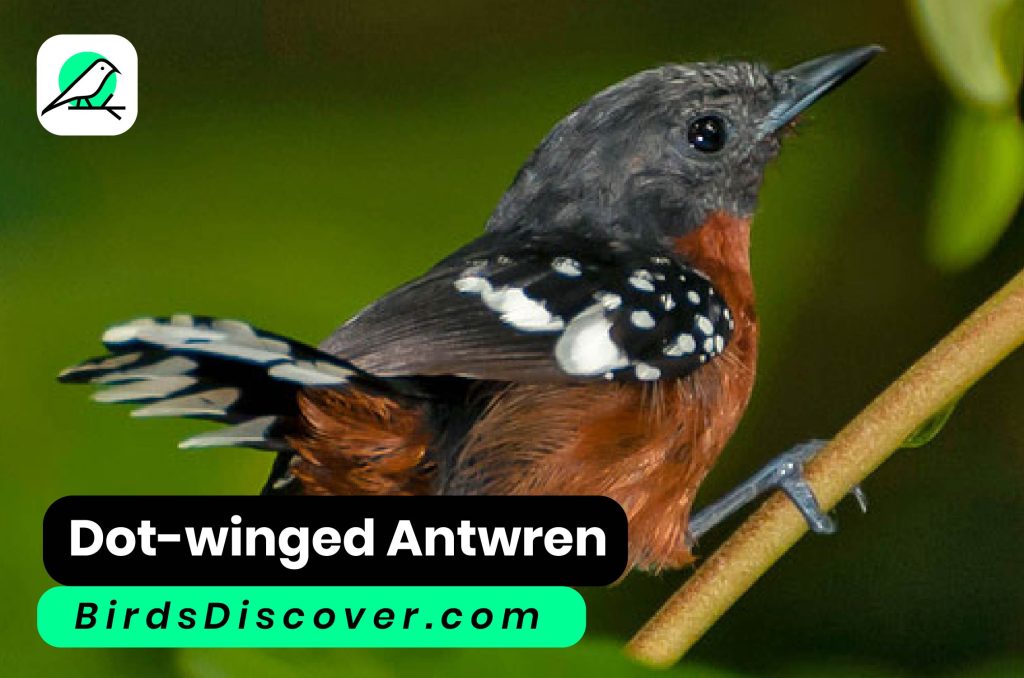
| Attribute | Description |
|---|---|
| Scientific Name | Microrhopias quixotes |
| Common Name | Dot-winged Antwren |
| Family | Thamnidae (Antwrens) |
| Habitat | Lowland and foothill forests, particularly in the Amazon Basin and parts of the Guianas and Brazil |
| Diet | Primarily insects and other small invertebrates |
| Breeding Season | Information on the specific breeding season is less documented; generally during the rainy season |
| Nest Location | Nests are typically constructed in dense vegetation or low shrubs, often hidden from view |
| Adult Plumage | Males: Olive-green upperparts with distinct black spots on the wings; Females: Duller with less pronounced markings |
| Juvenile Plumage | Similar to females but may have more streaking or mottling |
| Social Structure | Often found in small groups or pairs; can be seen in mixed-species flocks |
| Conservation Status | Least Concern (IUCN) |
| Notable Behavior | Known for its active foraging behavior and vocalizations; often stays close to the forest understory |
| Call | A variety of high-pitched calls and chattering sounds |
29. White-winged Becard
The White-winged Becard (Pachyramphus polychopterus) is a striking bird native to the tropical and subtropical forests of Central and South America. This member of the Tityridae family is noted for its distinctive plumage: males have black upperparts with prominent white wing patches, while females are similar but with less contrasting colors. The White-winged Becard primarily feeds on insects such as beetles, ants, and caterpillars, as well as small fruits. It nests in tree branches, constructing a deep cup-shaped nest during the breeding season, which typically runs from April to August. The bird is generally seen in pairs or small groups and can be found in mixed-species flocks, particularly within its forest habitat. Known for its active foraging behavior and distinctive vocalizations, the White-winged Becard is classified as Least Concern by the IUCN, indicating a stable population. Its striking appearance and behavior make it a notable species within its tropical and subtropical forest environment.
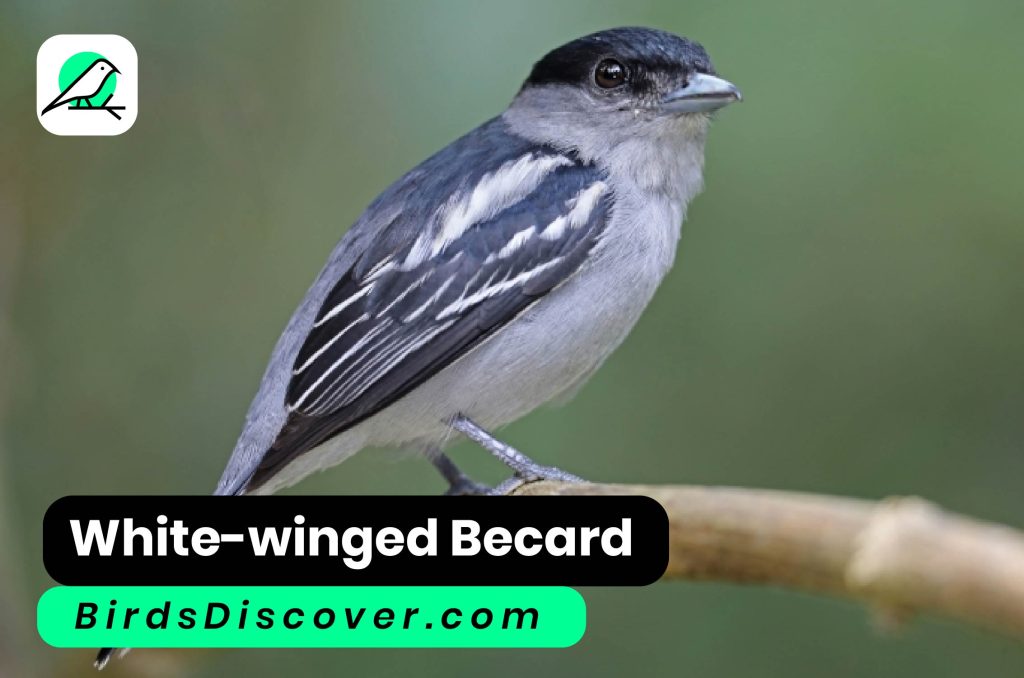
| Attribute | Description |
|---|---|
| Scientific Name | Pachyramphus polychopterus |
| Common Name | White-winged Becard |
| Family | Tityridae |
| Habitat | Tropical and subtropical forests, particularly in lowland and foothill regions of Central and South America |
| Diet | Primarily insects, including beetles, ants, and caterpillars; also feeds on small fruits |
| Breeding Season | Typically from April to August |
| Nest Location | Nests are built in tree branches, often in a deep cup shape |
| Adult Plumage | Males: Black upperparts with striking white wing patches; Females: Similar but with more subdued coloration |
| Juvenile Plumage | Similar to adults but with less contrast and more mottling |
| Social Structure | Generally seen in pairs or small groups; can be found in mixed-species flocks |
| Conservation Status | Least Concern (IUCN) |
| Notable Behavior | Known for its distinctive vocalizations and its behavior of actively foraging in the canopy |
| Call | A variety of chirping and whistling sounds |
30. Arnot’s Chat
Arnot’s Chat (Myrmecocichla arnotti) is a distinctive bird found in the arid and semi-arid regions of southern Africa, including scrublands and open woodlands. This member of the Muscicapidae family, also known as Old World flycatchers, is recognized by its dark brown plumage with a pale underbelly and notable white markings in males, while females are similar but generally less vibrant. Arnot’s Chat primarily feeds on insects and other small invertebrates, foraging actively within its sparse habitat. During the breeding season, from September to December, it builds its nest in low shrubs or grass, often on the ground or in low vegetation. The species is generally solitary or found in pairs and may form small groups outside of the breeding season. Known for its territorial calls and active foraging behavior, Arnot’s Chat is classified as Least Concern by the IUCN, indicating a stable population. Its unique appearance and adaptation to arid environments make it a notable species in its ecological niche.
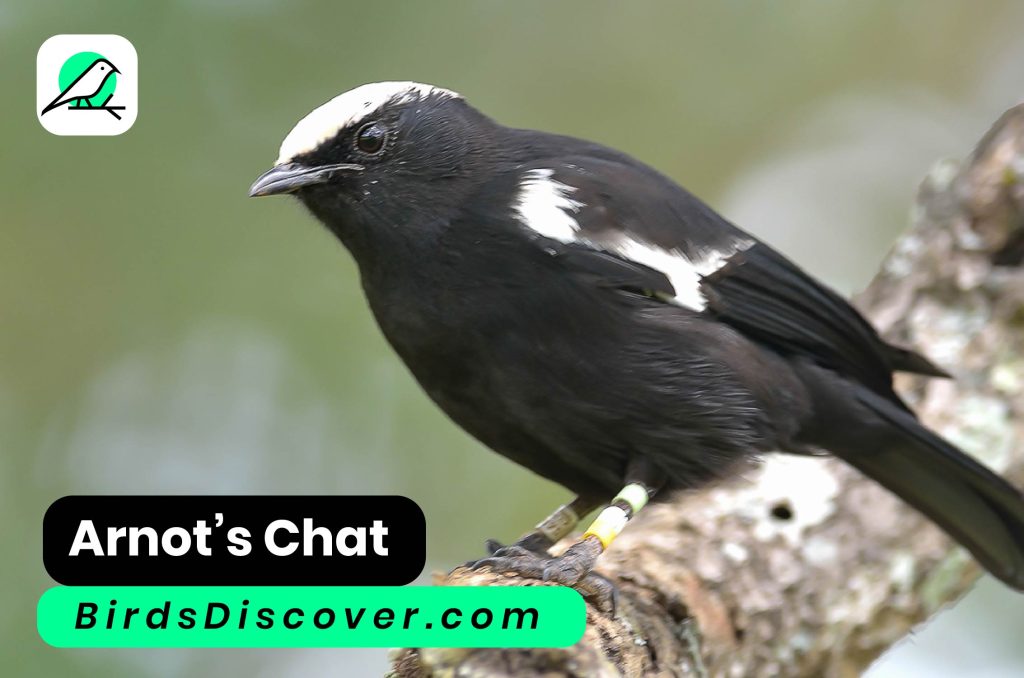
| Attribute | Description |
|---|---|
| Scientific Name | Myrmecocichla arnotti |
| Common Name | Arnot’s Chat |
| Family | Muscicapidae (Old World flycatchers) |
| Habitat | Arid and semi-arid regions, particularly in the scrublands and open woodlands of southern Africa |
| Diet | Primarily insects and other small invertebrates |
| Breeding Season | Typically from September to December |
| Nest Location | Nests in low shrubs or grass, often on the ground or in low vegetation |
| Adult Plumage | Males: Mostly dark brown with a pale underbelly and distinct white markings; Females: Similar but generally duller in color |
| Juvenile Plumage | Similar to females but with more mottling and less defined markings |
| Social Structure | Generally solitary or seen in pairs; can form small groups outside of the breeding season |
| Conservation Status | Least Concern (IUCN) |
| Notable Behavior | Known for its active foraging behavior and territorial calls; often seen perched prominently in its habitat |
| Call | A variety of sharp, chattering calls and whistles |
Conclusion
In conclusion, black birds are a fascinating and integral part of our natural world. Black birds, with their distinctive glossy feathers and varied behaviors, play significant roles in their ecosystems. The striking appearance of black birds, from the common blackbird to the red-winged blackbird, captures our attention and highlights their unique attributes. Black birds exhibit remarkable adaptability, thriving in diverse habitats and contributing to ecological balance.
The social behaviors of black birds, such as their large flocks and complex communication, are just a few of the many intriguing aspects of these avian species. Black birds also impact their environments through seed dispersal and insect control, further emphasizing their ecological importance. While black birds can sometimes be viewed as pests, their overall contributions to biodiversity and ecosystem health are undeniable.
Understanding and appreciating black birds enhances our connection to the natural world and underscores the need for conservation efforts. By recognizing the roles and behaviors of black birds, we can better appreciate the intricate relationships within our ecosystems. In summary, black birds, with their remarkable features and essential roles, continue to captivate and inspire those who take the time to observe and study them.
FAQS
1. What species of black birds have a white stripe on their wings?
Several species of black birds are known for having a white stripe or markings on their wings. Notable examples include the White-winged Blackbird (Agelaius icterocephalus) and the Black-collared Starling (Sturnus nigricollis). These species exhibit distinctive white wing patches or stripes that contrast sharply with their otherwise black plumage.
2. Where are black birds with white stripes on their wings commonly found?
Black birds with white stripes on their wings are found in various regions depending on the species. For instance, the White-winged Blackbird is native to parts of South America, particularly in areas like Argentina and Paraguay. The Black-collared Starling, on the other hand, is native to parts of Southeast Asia, including Indonesia and the Philippines. Each species has specific habitat preferences, such as open fields or forested areas, which can influence where these birds are commonly seen.
3. What is the purpose of the white stripe on the wings of these black birds?
The white stripe on the wings of black birds serves several purposes. Primarily, it plays a role in communication and species identification. In many species, the white wing markings are used in courtship displays or during territorial disputes to attract mates or ward off rivals. Additionally, these stripes can be a form of camouflage or distraction, helping the birds blend into their surroundings or confuse predators and prey.
4. How can you distinguish black birds with white stripes on their wings from similar species?
To distinguish black birds with white stripes on their wings, observe the color pattern and markings on their plumage. For example, the White-winged Blackbird has prominent white wing patches that are visible when the bird is in flight or perched. In contrast, the Black-collared Starling has a white stripe running along its wing but also features a black collar around its neck. Pay attention to additional features such as beak color, size, and song to accurately identify these birds among other similar species.
5. Are there any conservation concerns related to black birds with white stripes on their wings?
Conservation concerns for black birds with white stripes on their wings vary by species. Some may face threats from habitat loss due to deforestation or urbanization. For example, changes in land use can impact the availability of their preferred habitats. Additionally, climate change and environmental changes can affect their food sources and breeding conditions. Conservation efforts are essential to monitor these species and implement measures to protect their habitats and ensure their survival. It is important for bird watchers and conservationists to stay informed about these species and support efforts to preserve their natural environments.




